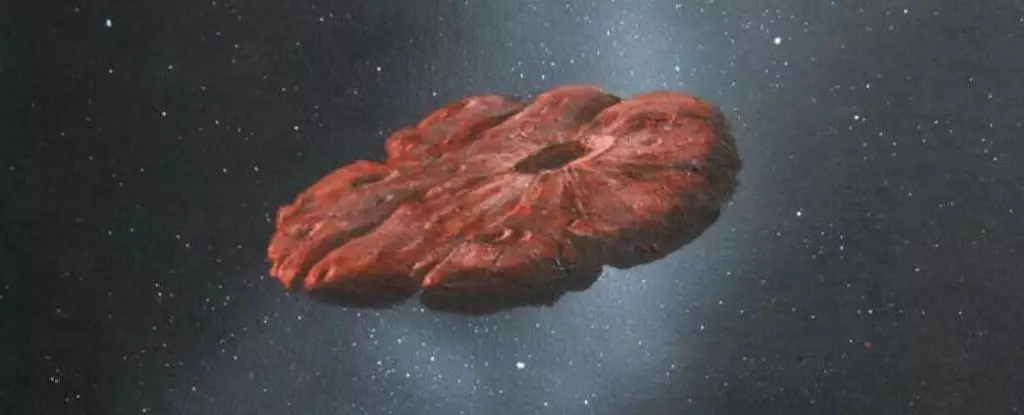In late 2017, humanity caught its first glimpse of something truly extraordinary. A fast-moving object streaked through our Solar System, and with it came excitement and bewilderment among astronomers globally. This object, which was named ‘Oumuamua—a Hawaiian term meaning “scout”—was unlike anything we had previously encountered. Measuring approximately 400 meters in length and displaying an elongated shape, it captured the essence of cosmic mystery while also serving as a beacon of curiosity.
The ‘Oumuamua event marked our first confirmed visit from an interstellar object (ISO), a relic from another star system that had ventured into our celestial neighborhood. These wandering bodies serve as planetary shrapnel, the remnants of violent astrophysical events such as collisions between planets. It’s theorized that ‘Oumuamua had traversed the Milky Way for hundreds of millions of years before this fateful encounter, stirring the imagination of scientists and space enthusiasts alike.
Just two short years later, a second ISO—dubbed the Borisov Comet—was discovered by an amateur astronomer in Crimea, further proving our universe’s vast and complex nature. Both of these cryptic visitors have provided tantalizing insights into the material composition of distant worlds. However, the pressing question remains: can we do more than mere observation?
The Challenge of Detection and Exploration
Despite the staggering number of potential ISOs—estimated to be over 10 septillion scattered across the Milky Way—humanity has only managed to detect two confirmed visitors. This disconnect between estimated numbers and actual sightings can be largely attributed to our current limitations in detection and interception technology. Big objects like ‘Oumuamua do not frequent our Solar System, and their high velocities compound the difficulties associated with early identification.
Currently, ground- and space-based telescopes often miss the opportunity to intercept these wanderers until after they’ve passed by. Our observational strategies need an urgent revamp as the window to catch these visitors is incredibly narrow; they move at remarkable speeds averaging over 32 kilometers per second, granting us less than a year’s notice to prepare for an encounter.
Emerging technologies, particularly in artificial intelligence (AI), could enhance our capabilities in tracking and engaging these cosmic nomads. Such breakthroughs might allow spacecraft to not just detect but intelligently navigate towards ISOs. Incorporating innovations seen in the study of space debris could potentially transform these fleeting visits into profound scientific endeavors.
Breaking Ground with Innovative Missions
Numerous projects are underway to push the boundaries of ISO exploration. NASA’s “Bridge” mission and the European Space Agency’s “Comet Interceptor” indicate the growing interest in interstellar encounters. “Bridge” aims to launch a spacecraft within 30 days of detecting an incoming ISO—a tall order considering how transient these events are. In contrast, the “Comet Interceptor,” expected to launch in 2029, will place its craft in a million-mile orbit, prepared to engage slow-moving comets or potentially capture ISOs.
Such preparations offer a glimpse into the future but also highlight challenges that need addressing. The feasibility of catching up with ‘Oumuamua, for example, illustrates the technical hurdles still ahead. The Institute for Interstellar Studies has suggested that, while it’s theoretically possible to pursue objects like ‘Oumuamua, the effort would require advanced technology and smarter ways of thinking.
Speed, Vision, and Materials: The Road Ahead
As we contemplate chasing ISOs, it is imperative that we enhance our spacecraft’s velocity and adaptability. Future missions can leverage cutting-edge AI and machine learning to refine object recognition and response strategies in real-time. In this regard, swarming micro-spacecraft capable of leveraging collective intelligence could revolutionize how we observe these distant objects.
The Vera C. Rubin Observatory in Chile is gearing up for a ten-year survey aiming to identify dozens of ISOs each year—building towards what could be a veritable explosion of detection opportunities. But once an ISO is spotted, spacecraft must reach high speeds quickly while maintaining the integrity of their energy sources, which may suffer degradation during long waits in orbit.
Exploration also hinges upon advancements in propulsion technology. Current missions have utilized solar sails that harness sunlight, proposing a lighter and more efficient means of travel. The next generation may even experiment with laser propulsion techniques to achieve unprecedented speeds.
Additionally, navigating the thermal extremes and potential collisions with space debris will require the development of lightweight, advanced materials. Research into carbon fibers, novel coatings, and innovative uses of traditional materials could enable spacecraft to endure the harsh conditions that await them while minimizing their weight.
A Call to Embrace Emerging Technologies
Achieving the dream of closely engaging with interstellar objects requires a multifaceted approach. Collaboration between ground-based telescopes and space missions is essential in orchestrating the timely interception of ISOs. Not only that, but we must foster an environment that encourages investment in emerging technology crucial for ASO exploration.
Alas, potential funding cuts to astrophysics missions and observatories, such as the revered James Webb Space Telescope, threaten the ambitious vision laid out for the future. A commitment to sustaining space science is imperative if we are to unlock the secrets hidden in the fabric of our cosmos. With ingenuity, collaboration, and tenacity, we stand on the brink of unveiling the unknown, capturing not just fleeting photographs but profound knowledge from the hearts of distant star systems.


Leave a Reply